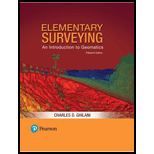
Concept explainers
Define the different reference meridians that can be used for the direction ofa line.
Define the different reference meridians that can be used
Answer to Problem 7.1P
True or Geodetic meridian
Magnetic meridian
Astronomic meridian
Grid meridian
Assumed meridian
Explanation of Solution
Given information:
Different reference meridians
Meridian is a reference with respect to which the bearing of a line is measured to represent the direction of the line.
True or Geodetic meridian:
True meridian is the imaginary line passing through the true North pole and true South pole at the point of the observer. True meridian is constant and does not change with time.
Magnetic meridian:
Magnetic meridian is the imaginary line passing through the magnetic North pole and magnetic South pole due to the magnetic. Magnetic meridian is not constant and it may change with time.
Astronomic meridian:
Astronomic meridian is the bigger circle passing through the North celestial poles and South celestial poles, the zenith and the nadir of the observer.
Grid meridian:
Grid meridian is formed when new lines are drawn parallel to the geodetic meridian in which zone we are preparing the local map.
Assumed meridian:
Assumed meridian is a meridian when the direction is assumed to the constant position of the zone.
Conclusion:
The meridians are very useful in determining the bearings of the line.
Want to see more full solutions like this?
Chapter 7 Solutions
Elementary Surveying: An Introduction To Geomatics (15th Edition)
Additional Engineering Textbook Solutions
Materials for Civil and Construction Engineers (4th Edition)
Foundation Design: Principles and Practices (3rd Edition)
Structural Analysis (10th Edition)
Fundamentals of Applied Electromagnetics (7th Edition)
Problem Solving with C++ (9th Edition)
- A given traversed has the following results: Total perimeter= 3,615.40m, Total Departures = 1,842.64m, Total Latitudes= 1,868.94m, Latitudes= +0.68, Departures= +0.42m. For line BC distance equals 394.60m and its latitude is 249.40N and departure is 364.20E. Compute the correct distance and bearing of line BC.arrow_forwardFind the area of 1+234 and 1+876arrow_forward23. If the surveyor is at Point A, and recorded the location of Line AB to be 200 degrees 35 minutes in WCB. The surveyor then recorded the location of Line AC to be 280 degrees 15 minutes in WCB. The length of AB is 530.68 meters and Length of AC is 275.45 meters. What is the length of the third line, Line BC?arrow_forward
- Why accuracy of the direction of the line is dependent on the accuracy of the coordinates?arrow_forwardFor the sketch ATTACHED, determine the horizontal distance AB and the elevation of Point B Starting Elevation at A is 50.00’ S (slope dist.) = 822.48 feet, Z (zenith angle) = 88º, hi = 5.15’, r = 5.00’arrow_forwardLine AB has the following data: Latitude = -588.25, Departure= +78.34, DMD = +78.34. Determine the double area (2A)arrow_forward
- The following are bearings and distances taken on a closed traverse. A line from vertex A to point F on the side BC divides the area and makes area ABF to be 280 000 m². Find the length of the line AF.arrow_forwardWrite down a unit vector in XY plan making angle 30° with the positive direction of x-axis?arrow_forwardLocate the X–X and Y–Y centroidal axes for the area shown. - Solve using Chart method writitng it outarrow_forward
- Civil engineering ( Survey): An equilateral triangle plot ABC is surveyed with compass in clockwise route. The fore bearing of line AB is 100°. discover the bearing of line BC and CA.arrow_forwardExplain the following: a. Azimuthb. Bearingc. Traverse d. Meridiane. Longitude and Latitudearrow_forwardcompute the distance of line CAarrow_forward

 Structural Analysis (10th Edition)Civil EngineeringISBN:9780134610672Author:Russell C. HibbelerPublisher:PEARSON
Structural Analysis (10th Edition)Civil EngineeringISBN:9780134610672Author:Russell C. HibbelerPublisher:PEARSON Principles of Foundation Engineering (MindTap Cou...Civil EngineeringISBN:9781337705028Author:Braja M. Das, Nagaratnam SivakuganPublisher:Cengage Learning
Principles of Foundation Engineering (MindTap Cou...Civil EngineeringISBN:9781337705028Author:Braja M. Das, Nagaratnam SivakuganPublisher:Cengage Learning Fundamentals of Structural AnalysisCivil EngineeringISBN:9780073398006Author:Kenneth M. Leet Emeritus, Chia-Ming Uang, Joel LanningPublisher:McGraw-Hill Education
Fundamentals of Structural AnalysisCivil EngineeringISBN:9780073398006Author:Kenneth M. Leet Emeritus, Chia-Ming Uang, Joel LanningPublisher:McGraw-Hill Education
 Traffic and Highway EngineeringCivil EngineeringISBN:9781305156241Author:Garber, Nicholas J.Publisher:Cengage Learning
Traffic and Highway EngineeringCivil EngineeringISBN:9781305156241Author:Garber, Nicholas J.Publisher:Cengage Learning





